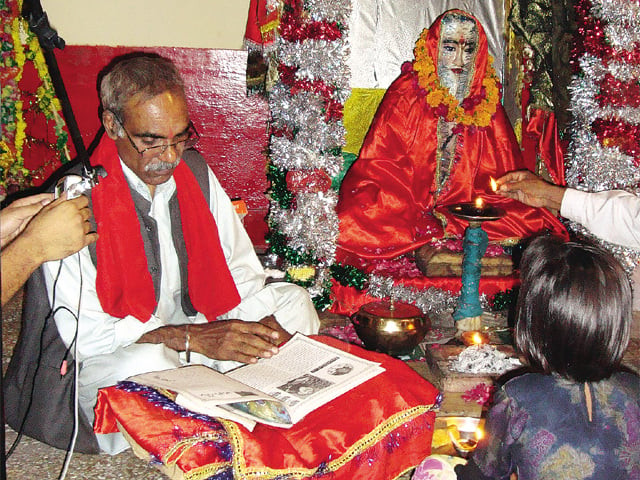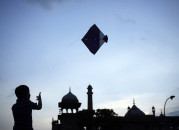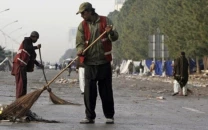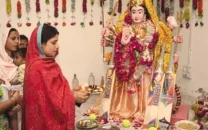Nila Gumbad Mandar: The story of a temple
Nila Gumbad Valmiki temple, a source of food and shelter for many.

This has been their custom for as long as they can remember — they have seen their fathers, grandfathers and great-grandfather gather here. But they ask themselves if they will see their sons continue the tradition. This is more than a temple to these people: it is their home; for the downtrodden, it is a source of free food; for travelers, it is a shelter for the night. Situated in the heart of the new Anarkali Market, Nila Gumbad Mandar, is a sanctuary that brings people together.
Originally, the street where it is located was called the Valmiki Street. A euphemism for untouchable, Valmiki is a caste, though for most people in the group, it embodies disassociation from Hinduism and hence is a different religion altogether. But for those not attentive to detail, Valmikis are Hindus. Christians and Muslims, who were once Hindu untouchables, are regular visitors to the temple. A Christian cross in the temple accommodates the syncretism. The main room is preserved for the worship of Valmiki, the supreme untouchable deity, and the author of the Ramayana. As long as one is an untouchable, it doesn’t matter if one is a Christian, Muslim or Hindu.
Bhagat Lal Khokhar, like his father Bhagat Labha Khokharbefore him, is a priest at the temple. His family has been living in Tollington Market for six generations. He arrives at the temple at 2 pm and stays till late in the night. His ritual pooja at 7 pm is attended only by a few regular visitors. Bhagat Lal used to set up a stall to sell stationery items near the old Punjab University campus. He no longer does that because business is poor. His two sons hold private jobs and don’t have the time to attend to temple duties.
The octogenarian Shams Gill is another regular at the temple. Once a wrestler nicknamed Hati pehlwan, nobody could best him in his heyday. Now he can barely stand. Born Khem Chand, he changed his name after the creation of Pakistan to improve his chances of getting a job. He is still a Valmiki, but his children have all converted to Christianity to secure a better future. Nonetheless, they are regular visitors of the temple. According to Shams Gill, there was a time when Hindus would treat both Valmikis and Muslims as untouchables but post-partition, Valmikis became untouchable for Muslims too. He recalls how, after he’d had food at a dhaba in Renala Khurd in the 1950s, the owner of the dhaba asked him to also pay for the plates they’d just had food in. Similarly, Bhagat Lal Khokhar remembers how in his childhood, the curd-man would make sure to never touch his pot while pouring. However, adds Bhagat Lal Khokhar wryly, the same curd-man had no scruples about touching the money that came from his hands. Both Shams Gill and Bhagat Lal assert, however, that things are much better now. There was a time when utensils for servants were separate; now the distinction has blurred.
On December 7, 1992, Shams Gill and Bhagat Lal Khokhar were at the temple along with Tara Chand and Bhagat Ashiq Ram. The Babri Mosque in India had been destroyed the day before. They were now waiting for its repercussions in Pakistan. Whereas normally they would have gotten together after 2 pm, today they had gathered at 10 am in the morning. Nobody had convened a
meeting; all of them knew they had to be there.
At around noon, they heard the shouts of a mob angrily marching towards them. The crowd, running in the hundreds, poured in, wielding sticks, hammers and other weapons. The Valmikis were no longer concerned about the temple — their own lives were at stake. Bhagat Lal walked towards his cycle but was intercepted by a man who seized it. Bhagat Lal did not even try to resist him. Another group attacked the community kitchen, picking up cauldrons, utensils and any other thing that they could lay their hands on. Not even iron bars in the ceiling were spared.
Inside the main room, the mob smashed the idol of Valmiki, a jewel-encrusted pre-Partition statue, made by students of the Punjab University. Similarly, the statue of Krishna, sculpted out of white marble, was also destroyed. No one knows what happened to a small lump of gold placed in front of Valmiki’s statue. What was important to them was that no Valmiki was hurt. The temple was destroyed in minutes and the entire structure was set on fire. The neighboring shops, too, caught fire and it is said that it took days for the authorities to get the fire under control.
Soon after, Bhagat Lal Khokhar had to leave his ancestral house and go underground with his family. For six months not even their close associates heard from them. Local newspapers speculated that they had migrated to India. He only re-appeared when the temple was up and running again.
Even though this group of senior Valmikis had remained passive when the mob attacked, they started writing to the authorities concerned to rebuild their temple as soon as the fire abetted. Within three months, the authorities allotted them money for construction. The rest of the money came from the members of the community. Before long the temple was the centre of this community once again. During its reconstruction, they preserved a part of wall from the original construction as a reminder of what had happened. The new Valmiki statue was in no way comparable to the original, whereas framed pictures replaced the idol of Krishna.
Today, people gather at the Nila Gumbad Mandar for religious functions, and usually attendees are those whose forefathers had been active members. Besides the Krishna Mandar at Ravi road, this is the only other functional Valmiki temple in the city of Lahore.
Published in The Express Tribune, December 5th, 2010.



















COMMENTS
Comments are moderated and generally will be posted if they are on-topic and not abusive.
For more information, please see our Comments FAQ